
A saltire, also called Saint Andrew's Cross or the crux decussata, is a heraldic symbol in the form of a diagonal cross. The word comes from the Middle French sautoir, Medieval Latin saltatoria ("stirrup").

The coat of arms of Nunavut was granted by a warrant of Roméo LeBlanc, Governor General of Canada, dated 31 March 1999, one day before the territory of Nunavut, Canada, was created. The same document specified the flag of Nunavut.

The coat of arms of Nova Scotia is the heraldic symbol representing the Canadian province of Nova Scotia. It is the oldest provincial achievement of arms in Canada, and the oldest British coat of arms in use outside Great Britain. It is blazoned as follows: Argent, a saltire azure charged with an escutcheon of the Royal Arms of Scotland.
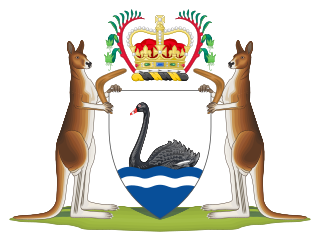
The coat of arms of Western Australia is the official coat of arms of the Australian state of Western Australia. It was granted by a royal warrant of Elizabeth II, Queen of Australia dated 17 March 1969.

The coat of arms of Australia, officially the Commonwealth Coat of Arms, is a formal symbol of the Commonwealth of Australia. It depicts a shield, containing symbols of Australia's six states, and is held up by native Australian animals, the kangaroo and the emu. The seven-pointed Commonwealth Star surmounting the crest also represents the states and territories, while golden wattle, the national floral emblem, appears below the shield.

Wellington City Council is a territorial authority in New Zealand, governing the city of Wellington, the country's capital city and third-largest city by population, behind Auckland and Christchurch. It consists of the central historic town and certain additional areas within the Wellington metropolitan area, extending as far north as Linden and covering rural areas such as Mākara and Ohariu. The city adjoins Porirua in the north and Hutt City in the north-east. It is one of nine territorial authorities in the Wellington Region.

The coat of arms of Yukon is the heraldic symbol representing the Canadian territory of Yukon. The arms was commissioned by the federal Department of Indian Affairs and Northern Development and designed by well-known heraldry expert Alan Beddoe in the early 1950s. It was officially approved by Queen Elizabeth II in 1956.
In heraldry, an ordinary is one of the two main types of charges, beside the mobile charges. An ordinary is a simple geometrical figure, bounded by straight lines and running from side to side or top to bottom of the shield. There are also some geometric charges known as subordinaries, which have been given lesser status by some heraldic writers, though most have been in use as long as the traditional ordinaries. Diminutives of ordinaries and some subordinaries are charges of the same shape, though thinner. Most of the ordinaries are theoretically said to occupy one-third of the shield; but this is rarely observed in practice, except when the ordinary is the only charge.
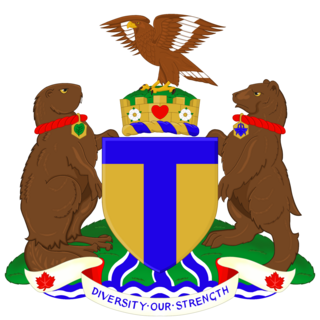
The coat of arms of Toronto is a heraldic symbol used to represent the city Toronto. Designed by Robert Watt, the Chief Herald of Canada at the time, for the City of Toronto after its amalgamation in 1998. The arms were granted by the Canadian Heraldic Authority on 11 January 1999.

A roundel is a circular disc used as a symbol. The term is used in heraldry, but also commonly used to refer to a type of national insignia used on military aircraft, generally circular in shape and usually comprising concentric rings of different colours. Other symbols also often use round shapes.

The coat of arms of Newcastle is the official heraldic arms of the City of Sunderland in England.
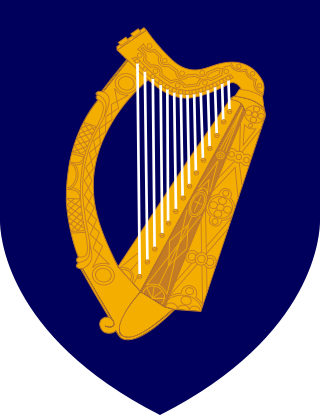
The coat of arms of Ireland is blazoned as Azure a harp Or, stringed Argent. These arms have long been Ireland's heraldic emblem. References to them as being the arms of the king of Ireland can be found as early as the 13th century. These arms were adopted by Henry VIII of England when he ended the period of Lordship of Ireland and declared Ireland to be a kingdom again in 1541. When the crowns of England, Scotland and Ireland were united in 1603, they were integrated into the unified royal coat of arms of kingdoms of England, Scotland and Ireland. The harp was adopted as the emblem of the Irish Free State when it separated from the United Kingdom in 1922. They were registered as the arms of Ireland with the Chief Herald of Ireland on 9 November 1945.
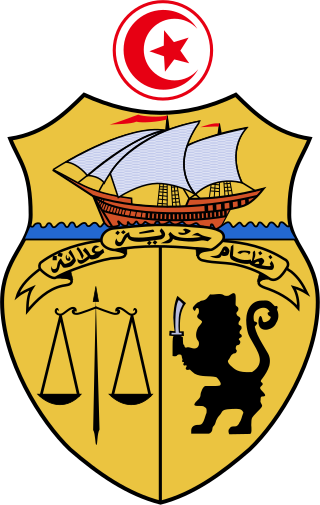
The coat of arms of Tunisia is divided into three parts. The upper part features a Carthaginian galley sailing on the sea. The lower part is itself divided vertically: on the left there is a black scale and on the right a black lion grasping a silver scimitar. Between the two parts is a banner bearing the national motto: “Freedom, Order, Justice”. Finally, at the top of the coat of arms is a circle with a red border into which is inserted the red crescent and star appearing on the flag of Tunisia.
The symbols of Queensland represent the Australian state of Queensland and the Queensland Government. The different symbols and emblems represent both the state and the government. The official state emblems of Queensland are prescribed in the Emblems of Queensland Act 2005.
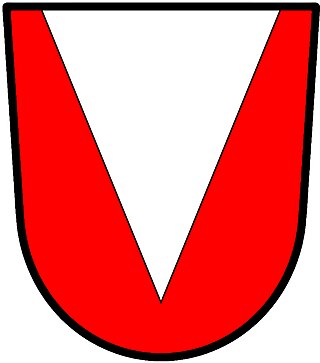
In heraldry, a pile is a charge usually counted as one of the ordinaries. It consists of a wedge emerging from the upper edge of the shield and converging to a point near the base. If it touches the base, it is blazoned throughout.

The coat of arms of Stellaland was the official heraldic symbol of the short-lived Stellaland state in South Africa from 1883 to 1885. It was later revived as the municipal arms of Stellaland's capital, Vryburg.

The Heraldry Society of New Zealand, established in 1962, is the principal New Zealand learned society concerned with the scholarly study of heraldry.
Coats of arms and seals of the County and Duchy of Cornwall, the Diocese of Truro, and of Cornish boroughs and towns.

The Bedfordshire flag is the flag of the English county of Bedfordshire. It is based on the banner of the arms of the former Bedfordshire County Council, which was granted the arms in 1951 by the College of Arms. This design was adopted as the flag of the historic county in September 2014, with the support of the High Sheriff of the county.

The standard of Prince Philip, Duke of Edinburgh, was the personal flag used by Prince Philip, Duke of Edinburgh. It displays his coat of arms and can thus be considered a banner of arms.

















